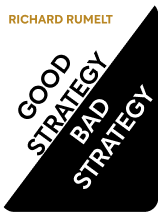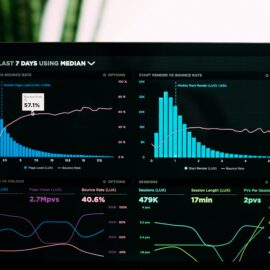

This article is an excerpt from the Shortform book guide to "Good Strategy Bad Strategy" by Richard Rumelt. Shortform has the world's best summaries and analyses of books you should be reading.
Like this article? Sign up for a free trial here .
What is organizational strategic planning? What factors should you consider when devising a big-picture strategy for an enterprise?
Organizational strategic planning is an organizational process of setting objectives and devising a plan for attaining them. According to Richard P. Rumelt, the author of Good Strategy, Bad Strategy, there are three general principles you should adopt when devising a big-picture strategy for your organization: 1) think like a scientist, 2) think like an analyst, and 3) avoid common faulty biases.
Keep reading to learn about these guidelines and demonstrate them with real-world examples.
Richard Rumelt: How to Think Like a Strategist
In his book Good Strategy, Bad Strategy, Richard Rumelt lays out three general guidelines to inform your strategic planning:
- Think like a scientist.
- Think like an analyst.
- Avoid common faulty biases.
1) Think Like a Scientist
Rumelt’s first approach to organizational strategic planning is to use the scientific method. The method involves a researcher testing a hypothesis—a prediction of how the world works—by observing if it holds up to experimentation in real life. A strategy is a type of hypothesis, and as strategists, we must measure its value by examining its success in practice—testing if our customers react to a price change as we are hoping, for example.
Often, a hypothesis starts with an “anomaly,” or something that grabs your attention because it represents a difference between what you observe and what you expect. In the world of science, this might mean questioning why snow doesn’t melt as fast as you’d expect it to when the weather warms up (a question that led to the discovery of thermodynamics). In the business world, an anomaly might lead you to ask why there are no upscale products offered by American fast-food companies (an observation that led to Starbucks). Recognizing an anomaly can lead you to unexpected opportunities that have been previously overlooked by competitors.
Case Study: Starbucks
Starbucks is a great example of a company employing the scientific method to improve its product and services.
In 1983, Howard Schultz traveled to Italy and noticed an anomaly when he observed the coffee house culture there. The Italian coffee house was different from anything he’d seen in the U.S., and he wondered why something similar had never been introduced state-side. He formed a hypothesis that Americans would embrace many of the Italian coffee house’s characteristics: the camaraderie between the customers, the showmanship of the baristas, and the quality product served in a fast format.
He tested his hypothesis by opening a small coffee house that faithfully replicated the Italian experience, down to the opera music in the background and the waiters in bow ties. Then, like a true scientist, he observed the results of his experiment by gauging customer reactions. As he gathered data on his customers’ preferences, he proceeded to alter his original model—for example, eliminating the opera music and the bow ties, but keeping the baristas central to the concept—until he had found a formula that resonated with the market. His final concept looked very unlike his first attempt but had developed a far stronger structure, based on how it worked in the real world rather than merely in his imagination.
Importantly, in order to enhance its experiment, Starbucks vertically integrated its operations, acting as its own roaster, brander, and retailer. By doing so, it was able to gather more data on its customers and adjust elements of its operations as needed to perfect its strategy by controlling more of the process. This vertical integration was innovative in the coffee industry and as a result, it acted as a protection against serious competition. Other coffee companies, especially European ones with deep experience in either roasting or retailing coffee beans and beverages, were slow to catch on to the new corporate structure until Starbucks was already well-established. This is again an illustration of using your advantage to make it difficult for your rivals to keep up.
2) Think Like an Analyst
To develop good strategies, you must also think like an analyst, consciously and carefully examining your challenges and options. Very often, the key to developing a good strategy is simply to devote the mental energy towards thinking about it in specific terms. Sitting down and directly thinking about the challenges and opportunities facing your organization can be enough to give you a leg up on the competition. Unfortunately, many leaders and organizations run on auto-pilot, assuming they generally know what they’re doing and where they’re heading. As a result, they don’t bother to give their strategies explicit thought.
There are many techniques you can use to analyze your organization’s challenges and opportunities. Some of these include:
- Make a list of challenges and opportunities.
- Look for alternative options.
- Make judgments.
We’ll explore each of these techniques further in the sections below.
Make a List of Challenges and Opportunities
The process of crafting a good strategy often starts with the basic exercise of making a list of the most important things for your organization to address in the near future. Though it may sound elementary, the act of writing your goals and objectives down on paper forces you to think through them in a way you may not be consciously doing on a day-to-day basis, and it can shed light on neglected aspects of your business.
Lists Prevent Forgetfulness
Making a list can prevent our human tendency to focus only on what’s directly in front of us and forget about other responsibilities. The human brain has a finite attention span and limited cognitive resources, and when we direct our attention to one issue, other issues sometimes get neglected. For example, a CEO might get caught up trying to lower costs on production and forget, for a while, about pushing innovation. Stepping back and consciously examining the management issues you face, your strengths, your weaknesses, and the ways that various departments interact with each other helps bring these issues to the forefront, reminding you of things you may have lost sight of while you were focused on other aspects of running your organization.
Lists Prioritize Goals and Action Plans
Making a list can also help you see which goals and action plans you should be devoting more time and resources to. When you get caught up in the daily operations of your organization, reactively making decisions moment-to-moment, you often end up with a shortsighted view of your challenges, and you might lose track of which operations and action plans are most important in the long run. Making a list can help you take a step back and see your organization with a wide-angle lens, allowing you to see where you might need to refocus energy and resources proactively, rather than reactively. Often, being strategic means simply being less myopic than others, whether those “others” are your colleagues or competitors.
Look for Alternative Options
Crafting good strategy also involves evaluating the complete set of options available to you. To do this, you must consciously seek out alternatives to the obvious solutions, to ensure you are not ignoring a potential solution hiding in the shadows.
When trying to solve problems, most people latch onto the first solution that pops into their heads. This is partly due to the way our brains have evolved: We don’t have the time or mental resources to thoroughly analyze every decision we come across on a daily basis, so we make snap judgments.
Often, this works out for us: The first solution that occurs to us is, in fact, the right one, such as which yogurt to have for lunch, or whether or not to speed up when approaching that yellow light. However, there are limits to the benefits of snap judgments. Though they may aid us with simple, everyday decisions, they are often less helpful when it comes to processing complex choices, like whether or not to merge with another company or to offer a new product line.
Complexity is filled with uncertainty, and our brains don’t like uncertainty. Sometimes we make snap judgments to convince ourselves that we’ve resolved that uncertainty. However, snap judgments rarely provide intelligent answers to complexity; when a problem is complex and ill-structured, with dozens of variables, unknowns, and no clear link between actions and outcomes, it can be difficult to know what the right answer is. For example, a company experiencing declining sales might face a wide variety of challenges causing that decline. Latching onto the first solution that occurs to it simply because it offers a way out of uncertainty might lead the company down the wrong path.
Once we’ve made a snap judgment, we run into another problem stemming from our human nature: We tend to defend an idea once we’ve settled on it. We don’t like to question our own decisions when it’s so much easier to just believe that we’ve hit the nail on the head. Thus, we’ll spend valuable time justifying a decision rather than examining it.
A better way to approach the process of collecting options is to practice looking for secondary and tertiary options. Making a list can be helpful here, too. Write down a list of all the challenges facing your organization, then come up with one or two solutions for each. Push yourself to move beyond the obvious solutions that present themselves first and to search for the ones that may be less obvious, as these may be less obvious to competitors as well.
Critique Your Options
To avoid becoming committed to a decision that may not be the best choice, test it out by “vetting” it through a mental panel of critiquers made up of people you know well and whose opinions you value. Doing this can shed light on aspects of the decision you might otherwise overlook.
A trusted advisor, be it in business or your personal life, has a specific personality and a point of view that you can probably predict. Having a virtual conversation with her based on her imagined response to an issue or decision can be almost as helpful as having a real conversation. For example, maybe one of your former professors always focused on the broader implications of change in an industry; you might imagine she’d ask you to think through how your decision might open or close opportunities for you next year. Or maybe a colleague is always talking about a company’s proprietary information; she might ask you what makes your solution difficult for your competitors to replicate.
Make Judgments
In the end, strategy is a judgment call—an educated guess about what will lead your organization to success or failure. Arriving at that call is an important step. Once you’ve examined all possible options from all possible angles, you must then commit to a plan of action. Committing to something gives you a starting point and a point of comparison from which you can evaluate other action plans, priorities, and diagnoses of the challenges. Sometimes choosing among endless options is more difficult than deciding between two, and if you commit one option, it’s easier to evaluate other options by asking are they better or worse than this particular one. Be open to other peoples’ arguments, and don’t defend your position against reasonable pushback, but do choose a platform to compare other judgments against.
3) Avoid Common Faulty Biases
When strategy fails, a company often goes out of business or an organization ceases to operate. On a governmental level, failed strategy can result in an economic crash or a lost war. Such failures are often the result of failures of thinking, and typically can be categorized into one (or more) of five common faulty biases:
1. The “engineering overreach” bias: where strategy designers fail to analyze or comprehend the ways in which their design can fail, as well as the consequences of such failure. For example, the innovative financial instruments created in the 2000s that led to the financial collapse of 2008 were not well understood by either the bankers who sold them or their customers—and no one fully understood the consequences of the system failing.
2. The “smooth sailing” bias: where people believe that when things are going well, they will continue to go well. Unfortunately, some designs are built with a critical design flaw that doesn’t reveal itself until it is catastrophically triggered. In other words, everything in a system might work well with no warning tremors until all at once, the entire design collapses. To continue the previous example, when bankers, mortgage lenders, and the government built an entire financial industry on the premise that home prices will never decline, they failed to see the fundamental design flaw that only revealed itself when things started to collapse—and then everything collapsed at once.
3. The “risk-seeking” bias: where people are incentivized to seek risks because they keep profits when things go well but other people shoulder the losses when things go poorly. This behavior can be seen in the financial industry when banks take on more debt than they can cover and eventually get bailed out by the government, as did Long-Term Capital Management in 1998. These bailouts only encourage future excessive risk taking, because they set the example that should a gamble fail, the bank that made it won’t suffer the consequences.
4. The “social herding” bias: where people ignore obvious problems simply because other people are ignoring them. This happens because when we don’t understand something, our human nature instructs us to seek guidance from other people. Unfortunately, when everyone shares the same level of misunderstanding, they end up in a “blind leading the blind” situation, with everyone believing that everyone else knows what they’re doing, even when that’s not the case. This bias partly explains what happened leading up to the 2008 financial collapse. Everyone assumed that because everyone else was betting big on mortgage-backed securities, the strategy must be sound.
5. The “inside view” bias: where people see themselves, their group, their organization, their country, or their era as different and special, believing that what happens to other people can’t happen to them. For example, most people know that talking on a phone while driving greatly increases your risk for accidents, but they often falsely believe that they themselves are exempt from this risk because they trust their own driving skills, a fallacy which leads people to continue to engage in this risky behavior even knowing the statistics.
In the business world, we saw this false thinking again in the lead-up to the 2008 crash, when people convinced themselves that this particular economic bubble would not burst in the way previous bubbles had because it was different for a number of reasons—for example, people believed America’s financial markets were robust enough to absorb shocks and that the Federal Reserve was skilled enough to prevent them. Everyone ignored the fact that the rise was simply another real-estate-fueled bubble like many others before it, and was just as liable to burst.
Each of these biases leads us to ignore important information and aspects of a strategy that might lead to ruin. Be aware of these biases when you encounter them and prepare to push back against them. When you detect such biases in a group of people discussing and designing strategy, look for outside data that might refute such group-think.
Case Study: Global Crossing
The collapse of the telecommunications developer Global Crossing illustrates these biases in action. In the late 1990s, the company began laying cable across the Atlantic Ocean to connect North America’s telecommunication networks to Europe’s. The stock market backed them enthusiastically; six months after the company’s Initial Public Offering on the stock market, the market valued it at $38 billion—more than the Ford Motor Company—even though its profits were only promises at that point.
However, the company was unable to make its investments profitable and in December 2001, saddled with debt, it filed for bankruptcy. It had misjudged its own competitive advantages and long-term strengths by falling for four of the five biases outlined above:
1. Engineering overreach: The company ignored the flaws in its strategy design. First, once their cables had been laid across the ocean floor, the cost to move a call across them was essentially zero. The overhead was almost entirely made up of up-front expenses and fixed maintenance costs, which remained the same no matter how many calls traveled the wires. This meant that there was nothing justifying charging high rates to customers, and in a competitive market where two or more companies were vying for those customers, prices were likely to drop dramatically. (In this way, Global Crossing ignored the ideal state that we mentioned earlier—the state customers would drive the industry to in a quest for efficiency—and instead focused on the ways that their own particular company might benefit from imagined industry dynamics.)
Second, their technology was not proprietary; any competitor could enter the market with the same resources. Third, because technology costs were continuing to decrease, competitors were incentivized to add capacity, which could only lead eventually to a huge oversupply and thus a price crash.
2. Smooth sailing: After laying their first cable across the ocean, the company looked to be on a solid foundation; they were able to sell their capacity for more than they’d spent on construction. They assumed this dynamic would continue. Additionally, no other communications company had yet imploded by following this business model. They therefore assumed no one ever would.
3. Social herding: The stock market valued Global Crossings highly. This led the company’s own executives and consultants, along with other industry players and competitors, to believe that their strategy must be sound. Instead of examining the clear flaws in their business model, they took their lead from investors, who in turn, took their lead from the company’s confidence. It was a circular system of approval in which everyone assumed everyone else knew what they were doing.
4. Inside view: The company dismissed issues like price competition by reasoning that their industry was novel and operated differently from other industries, insisting they’d be insulated from the price pressures of competition for many years before the more established communications companies caught up to them. But clearly, their belief in their own specialness was delusional: As discussed, the company’s product, the Internet, failed to generate revenue because it was essentially a free resource, and competing companies could build the same infrastructure at a fraction of the cost—consumers wouldn’t pay Global Crossing for a nearly-free product they could get for less somewhere else. In believing they were unique and that the laws of economics didn’t apply to them, Global Crossing ignored the fact that they were a company like any other and, as such, would have to make a profit to survive.
In Conclusion
A good strategy is often the key difference between success and failure. Crafting good strategy involves ignoring much of the advice and models that are currently out there guiding corporations and governmental agencies. It means knowing the difference between goals and strategies. It means examining your own organization, your competition, and the wider landscape for opportunities and threats and then centering your plans around them. It takes dedicated effort to strategize well, but it’s always worth the time.

———End of Preview———
Like what you just read? Read the rest of the world's best book summary and analysis of Richard Rumelt's "Good Strategy Bad Strategy" at Shortform .
Here's what you'll find in our full Good Strategy Bad Strategy summary :
- The essential components of good strategy and the faulty thinking behind bad strategy
- Specific and measurable techniques for designing a focused strategy for success
- How to overcome challenges and gain a competitive edge






